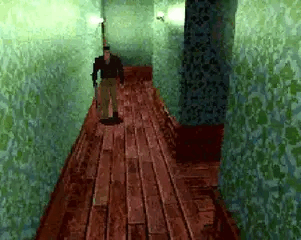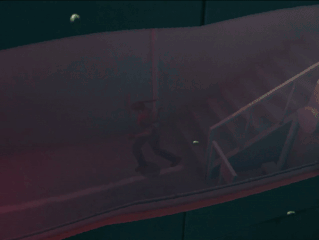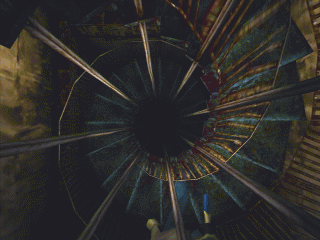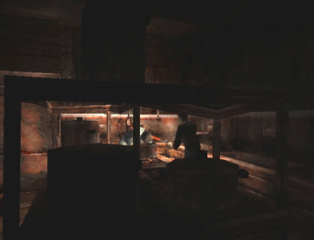Horror in Fixed Camera Angles
last edited nov 4, 2021
Survival horror. Resident Evil used the term for the first time in 1996 but notable entries to the now genre include Silent Hill, Alone In The Dark, Dead Space and countless others. At its peak popularity it was almost synonymous with fixed camera angles and as a result, tank controls too.
Fixed camera angles - also occasionally referred to as a cinematic camera - in our context refers to a camera system in game where players don't have direct control over their view, either having completely static views or are set on a predetermined axis that you are unable to influence. "The view of the world presented is outside of player control". Fixed camera angles have been seen outside of the realm of survival horror - see Devil May Cry - but it's within its genre where it really shines.
1992 saw the release of Alone In The Dark, the first game to utilise this camera system, becoming a forefather of the genre yet to be named survival horror. The use of a cinematic camera was used because of the limitations of hardware, having prerendered backgrounds saved memory while allowing a level detail you couldn't feasibly achieve otherwise. Resident Evil used prerendered backgrounds for the same reason. Shinji Mikami wasn't comfortable with the level of detail in the first person prototype they were developing and upon seeing Alone In The Dark, eventually changed course, allowing for the Resident Evil we know today.
The final release saw Resident Evil use fixed camera angles to their advantage, hiding enemies behind walls where you could only hear their groans and shuffling. It created apprehension, not knowing what's coming next, or if it's better to fight or run. This threat of the unknown drives tension in a similar way to horror movies, where people might criticise fixed camera angles for removing you from the direct perspective of your character or breaking immersion, its strength is allowing for more ways to experience the horror. Its its own type of cinematography, drawing from film and making it work in the context of the game. Some of my favourite shots in Resident Evil are from angles where you see the environment as an outsider looking in, giving the feeling that you're always being watched - with that not being an entirely outlandish idea as you explore your surroundings, unaware of who or what lay ahead. Resident Evil 2 and 3 made more use of wider angles compared to their predecessor - combining the claustrophobic, narrow rooms with wide open streets giving the feeling of being exposed. Even disregarding the effect these angles have on the player, the series' prerendered backgrounds are just beautiful to look at even 20 years later.


Resident Evil: Deadly Silence, 2006 / Resident Evil CODE:Veronica, 2000
Pivoting to another survival horror staple, Silent Hill doesnt strictly use fixed camera angles, instead using them sparingly to draw attention to important locations or take their cinematic aspect to the next level. While the instances of a fixed camera are less than that of Resident Evil, their effect certainly can still be felt. The opening of Silent Hill uses it to great effect, utilising a swooping camera walking down the narrow alleyway, making the player feel disorientated before they find the real horrors at the end. Being a fully 3d game, Silent Hill and its sequels were able to adapt its fixed camera to something slightly more dynamic, something Resident Evil: Code Veronica also toyed with.


Silent Hill, 1999
Fixed camera angles go hand in hand with the often criticised tank controls. This control system was named because of how old tanks were controlled, unable to change direction freely. Forward is forward, while slowly pivoting left or right when required to change directions. There were slight quality of life adjustments made to these controls over the years, such as implementation of a 180 quickturn, allowing for an easier out when encountering danger, but the core of them are the same. While they are clunky, somewhat slow and hard to use at first, in my eyes there' no way to use fixed camera angles without them. The remaster of Resident Evil Remake and Resident Evil 0 offered the option of an 'alternate' control scheme to the original, making it more appealing for modern audiences all too aware of the grievances of tank controls. In theory this sounds great, but in reality it makes controlling these games inconsistent and uncomfortable. There is no way for a character to move smoothly between camera angles without tank controls, as they control a character from their own view rather than the cameras. Between the memories of games poorly executing the control scheme and the intimidating learning curve, tank controls have been pushed into obscurity despite having since been recognised by fans as the definitive way to experience these games. The slow and deliberate nature of these controls lends itself to these games and are not a mistake no matter how many complaints this system gets. They feel at home with fixed camera angles and yet is the reason the style hasn't returned outside of indie developers.
While I doubt that we will ever see a return to fixed camera angles like there once was, there are a handful of indie games that are using them wonderfully. Alisa, a game by Casper Croes, is dedicated to recreating ps1 era survival horror - even down to not being able to navigate stairs freely - while not being a lifeless clone. Tormented Souls also makes use of them while implementing the new capabilities in hardware over the past 20 years at the same time. It uses a fully 3d environment similar to games before it, with a higher polygon count & pretty shaders, cementing it as a truly modern take on the style. These games, passion projects from developers that love these games themselves, are opening up new doors for more games like it to follow.
Despite the mainstream gaming landscape no longer caring for this niche, there will always be dedicated fans advocating for its survival and appreciating the games we do have. Both on an aesthetic & gameplay level, these games won't be forgotten anytime soon.